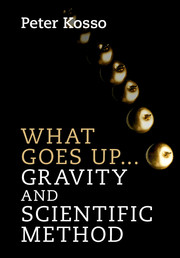Additional References
Baum, R. and Sheehan, W. (1997). In Search of Planet Vulcan. New York: Plenum.
Bentley, R. (1838). Works of Richard Bentley, volume 3. London: AMS Press.
Bridgman, P. (1955). Reflections of a Physicist. New York: Philosophical Library.
Clark, R. (1972). Einstein: The Life and Times. New York: Avon Books.
Clowe, D., Bradac, M., Gonzalez, A., et al. (2006). A direct empirical proof of the existence of dark matter. The Astrophysical Journal, 648, L109–L113.
Copernicus, N. (1952, first published 1543). On the Revolutions of the Heavenly Spheres, translated by Wallis, C.. In Great Books of the Western World, volume 16, ed. Hutchins, R.: Chicago, London, Toronto: Encyclopedia Britannica, pp. 497–838.
Dear, P. (2009). Revolutionizing the Sciences, second edition. Princeton: Princeton University Press.
Einstein, A. (1920). Relativity: the Special and General Theories. New York: Henry Holt.
Einstein, A. (1936). Physics and reality. The Journal of the Franklin Institute 221 (3), 349–382.
Eisenstein, E. (1979). The Printing Press as an Agent of Change. New York: Cambridge University Press.
Feyerabend, P. (1993). Against Method, third edition. New York: Verso.
Galileo, (1953, originally published in 1632). Dialogue Concerning the Two Chief World Systems, translated by Drake, Stillman. Berkeley, CA: University of California Press.
Hoskin, M. ed. (1999). The Cambridge Concise History of Astronomy. Cambridge: Cambridge University Press.
Hoskin, M., Gingerich, O. (1999). Medieval Latin astronomy. In The Cambridge Concise History of Astronomy, ed. Hoskin, M.. Cambridge: Cambridge University Press, pp. 68–93.
Jeffreys, H. (1919). On the crucial test of Einstein's Theory of Gravitation. Monthly Notices of the Royal Astronomical Society, 80 (2), 138–154.
Kepler, J. (1952, first published 1618). Epitome of Copernican Astronomy, translated by Wallis, C.. In Great Books of the Western World, volume 16, ed. Hutchins, R.. Chicago, London, Toronto: Encyclopedia Britannica, pp. 839–1004.
Kepler, J. (1992, first published 1609). New Astronomy, translated by Donahue, W.. Cambridge: Cambridge University Press,
Kuhn, T. (1977). The Essential Tension. Chicago: University of Chicago Press.
Kuhn, T. (1996). The Structure of Scientific Revolutions, third edition. Chicago: University of Chicago Press.
Lange, M. (2002). An Introduction to the Philosophy of Physics: Fields, Energy, and Mass. Oxford: Blackwell.
Lloyd, G. (1974). Early Greek Science: Thales to Aristotle. New York: Norton.
Mach, E. (1911). History and Root of the Principle of the Conservation of Energy. Chicago: The Open Court Publishing.
Moore, P. (1996). The Planet Neptune, second edition. New York: Halstead Press.
Newton, I. (1995, first published 1687). The Principia, translated by Motte, A.. Amherst, NY: Prometheus Books.
Ohanian, H. (2008). Einstein's Mistakes: The Human Failings of Genius. New York: Norton.
Pais, A. (1982). Subtle Is the Lord. Oxford: Clarendon Press.
Reichenbach, H. (1958). The Philosophy of Space & Time, translated by Reichenbach, M. and Freund, J.. New York: Dover Publications.
Roseveare, N. T. (1982). Mercury's Perihelion, from Le Verrier to Einstein. Oxford: Oxford University Press.
Sachs, M. (1973). The Field Concept in Contemporary Science. Springfield: Charles C. Thomas.
Schwarzschild, B. (2006). Collision between galaxy clusters unveils striking evidence of dark matter. Physics Today, 59 (11), 21–24.
Sciama, D. (1969). The Physical Foundations of General Relativity. New York: Doubleday.
Sklar, L. (1974). Space, Time, and Spacetime. Berkeley, CA: University of California Press.
Standage, T. (2000). The Neptune File. New York: Walker & Company.
Turnbull, H., Scott, J., Hall, A. (1959). The Correspondence of Isaac Newton, volume 1. Cambridge: Cambridge University Press.
van den Bergh, S. (1999). The early history of dark matter. Publications of the Astronomical Society of the Pacific, 111 (760), 657–660.
Vitruvius, (2001, original c. first century BC). Ten Books on Architecture, translated by Rowland, I., edited by Rowland, I. and Howe, T.. Cambridge: Cambridge University Press.
Will, C. (1986). Was Einstein Right? New York: Basic Books.



